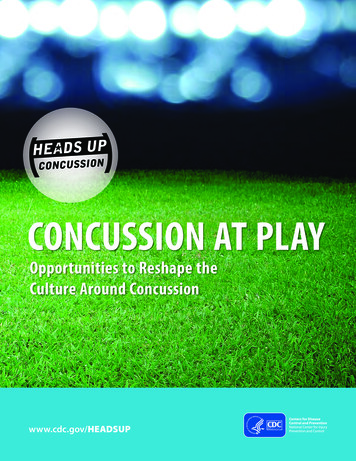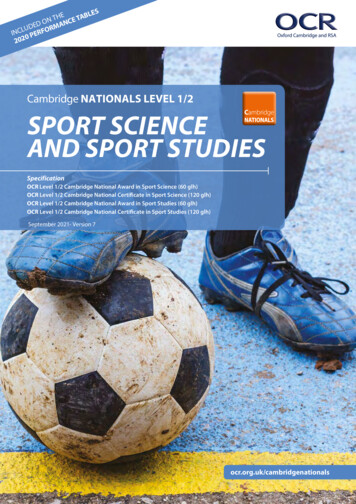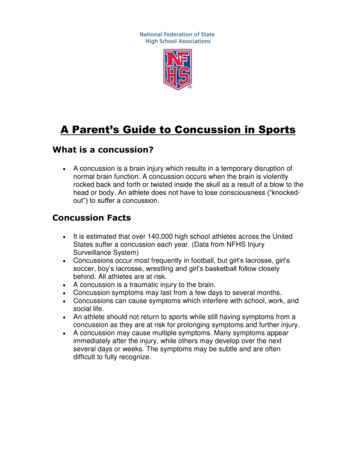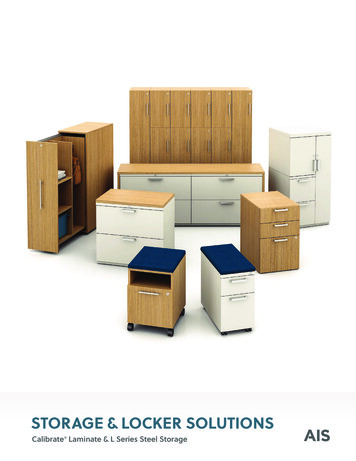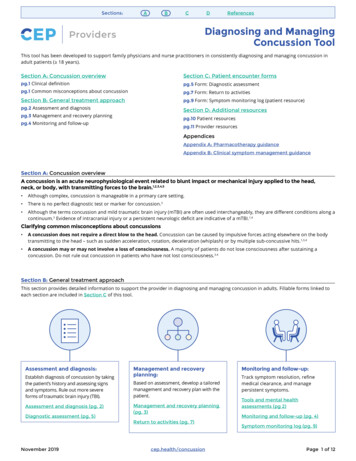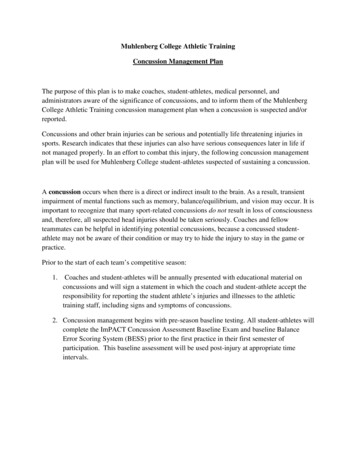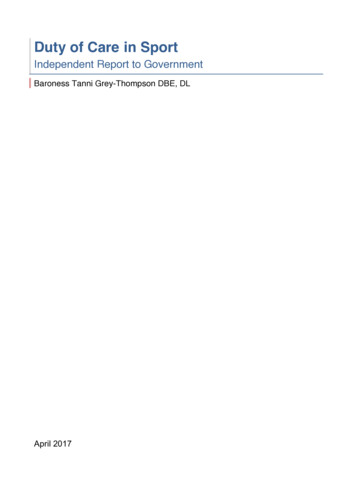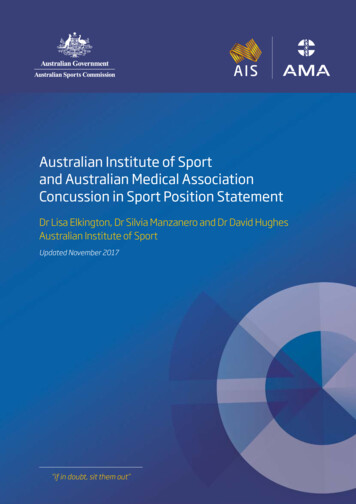
Transcription
Australian Institute of Sportand Australian Medical AssociationConcussion in Sport Position StatementDr Lisa Elkington, Dr Silvia Manzanero and Dr David HughesAustralian Institute of SportUpdated November 2017“if in doubt, sit them out”
Concussion Position StatementContents1) EXECUTIVE SUMMARY12) AIS-AMA POSITION STATEMENT ON CONCUSSION IN SPORT2a.Introductionb.What is concussion?c.Recognising concussiond.Medical assessment of concussione.Predictors of clinical recoveryf.Managing concussiong.Children and adolescentsh.Long-term consequencesi.Educationj.Concussion research prioritiesk.Key Points for coaches, parents and athletesl.Key Points for medical practitioners3) OVERVIEW OF ogyp.Assessment of suspected sport-related concussionq.Evidence-based assessment toolsr.Managements.Children and adolescentst.Investigationsu.Predictors of clinical recoveryv.Special considerations in concussionw.Education and prevention144) GUIDELINES IN AUSTRALIAN SPORTING ORGANISATIONS215) OTHER CONCUSSION RESOURCES226) CONCUSSION RESEARCH PRIORITIES237) REFERENCES24
1.EXECUTIVE SUMMARYThere has been growing concern in Australia and internationally about the incidence of sport-relatedconcussion and potential health ramifications for athletes. Concussion affects athletes at all levels of sportfrom the part-time recreational athlete to the full-time professional. If managed appropriately most symptomsand signs of concussion resolve spontaneously. Complications can occur however, including prolonged durationof symptoms and increased susceptibility to further injury. There is also growing concern about potential longterm consequences of multiple concussions. The Australian Institute of Sport (AIS) is Australia’s peak highperformance sport agency. The Australian Medical Association (AMA) is the peak membership organisationrepresenting the registered medical practitioners (doctors) and medical students of Australia. Both AIS andAMA have clear and unequivocal focus on ensuring the safety and welfare of Australians participating in sport.Over recent years there has been elevated public awareness of sport-related concussion and increased focuson the importance of diagnosing and managing the condition promptly, safely and appropriately. There hasalso been concern over the possible long-term consequences of recurrent concussion.Sport administrators, medical practitioners, coaches, parents and athletes are seeking information regardingthe timely recognition and appropriate management of sport-related concussion. There is need for clear,unequivocal and reliable information to be readily accessible to all members of the community.Funded by the Australian Government, this AIS/AMA Position Statement on Concussion in Sport bringstogether the most contemporary evidence-based information and presents it in a format that is appropriatefor all stakeholders. The AIS and AMA seek to ensure that all members of the public have rapid access toinformation to increase their understanding of sport-related concussion and to assist in the delivery of bestpractice medical care.This updated version includes the latest advancements in evidence-based management of concussionin children, and the latest evidence presented by the Concussion in Sport Group at the 2016 ConsensusConference. This update ensures that this Position Statement remains consistent with contemporary evidence.This Position Statement is intended to ensure that participant safety and welfare is paramount when dealingwith concussion in sport.1“if in doubt, sit them out”
2. A IS-AMA POSITION STATEMENTON CONCUSSION IN SPORTIntroductionSport-related concussion is a growing health concern in Australia. It affects athletes at all levels of sportfrom the part-time recreational athlete to the full-time professional. Concerns about the incidence, andpossible health ramifications for athletes, have led to an increased focus on the importance of diagnosingand managing the condition safely and appropriately1,2. Parents, coaches, athletes, medical practitioners andothers involved in sport are seeking information regarding the best management of sport-related concussion.Participant safety and welfare is paramount when dealing with all concussion incidents.The Australian Institute of Sport (AIS) is Australia’s peak high-performance sport agency. The AustralianMedical Association (AMA) is the peak membership organisation representing the registered medicalpractitioners (doctors) and medical students of Australia. Both AIS and AMA have clear and unequivocal focuson ensuring the safety and welfare of Australians participating in sport.Funded by the Australian Government, this position statement aims to: provide improved safety and health outcomes for all people who suffer concussive injuries whileparticipating in sport, assist all sporting organisations and clubs to align their policy and procedures to the most up-to-date evidence, protect the integrity of sport through the consistent application of best practice protocols and guidelines, provide a platform to support the development of national policy for the management of concussion inAustralia.What is concussion?Concussion is a traumatic brain injury, induced by biomechanical forces to the head or anywhere on thebody, which transmits an impulsive force to the head3,4. It causes short-lived neurological impairment andthe symptoms may evolve over the hours or days following the injury. The symptoms should resolve withoutmedical intervention3. Rest, followed by gradual return to activity, is the main treatment5. Evidence from animaland functional imaging studies points toward a series of interrelated biochemical and physiological changesthat impair neuronal function6,7.Recognising concussionRecognising concussion can be difficult. The symptoms and signs are variable, non-specific and may be subtle.Onlookers should suspect concussion when an injury results in a knock to the head or body that transmits aforce to the head. A hard knock is not required, concussion can occur from relatively minor knocks.There may be obvious signs of concussion such as loss of consciousness, brief convulsions or difficultybalancing or walking. However, the signs of concussion can be more subtle. The Sport Concussion AssessmentTool (SCAT5) identifies 22 possible symptoms8-10. headache ‘don’t feel right’ ‘pressure in the head’ blurred vision sadness difficulty concentrating drowsiness feeling like ‘in a fog’ neck pain balance problems nervous or anxious difficulty remembering sensitivity to light nausea or vomiting more emotional trouble falling asleep(if applicable) fatigue or low energy sensitivity to noise dizziness irritability confusion feeling slowed down“if in doubt, sit them out”2
Recognising concussion is critical to correct management and prevention of further injury. The ConcussionRecognition Tool (CRT5), developed by the Concussion in Sport Group to help those without medical trainingdetect concussion, includes a list of these symptoms11,12.When an athlete is suspected of having a concussion, first aid principles still apply, and a systematic approachto assessment of airway, breathing, circulation, disability and exposure applies in all situations. Cervical spineinjuries should be suspected if there is any loss of consciousness, neck pain or a mechanism that could lead tospinal injury. Manual in-line stabilisation should be undertaken and a hard collar applied until a cervical spineinjury is ruled out.A medical practitioner should review any athlete with suspected concussion. In a situation where there is noaccess to a medical practitioner, the athlete must not return to sport on the same day. If there is any doubtabout whether an athlete is concussed that athlete should not be allowed to return to sport that day. Anathlete with suspected concussion should be reassessed to look for developing symptoms and cleared by amedical practitioner before returning to sport12. Due to the evolving nature of concussion, delayed symptomonset is not unusual3. Therefore, any athlete cleared to return to sport after medical assessment for suspectedconcussion should be monitored closely during the game/competition for developing symptoms or signs. Ifsymptoms develop, the athlete should be removed from sport.Sometimes there will be clear signs that an athlete has sustained a concussion. Medical practitioners coveringsporting events should immediately remove from sport an athlete with any of the following clinical features: loss of consciousness no protective action taken by the athlete in a fall to ground, directly observed or on video impact seizure or tonic posturing confusion, disorientation memory impairment balance disturbance or motor incoordination (e.g. ataxia) athlete reports significant, new or progressive concussion symptoms dazed, blank/vacant stare or not their normal selves behaviour change atypical of the athlete.Athletes displaying any of these signs should be treated as concussed and not be returned to sport.Some features suggest more serious injury and athletes displaying any of these signs should be immediatelyreferred to the nearest emergency department: neck pain increasing confusion, agitation or irritability repeated vomiting seizure or convulsion weakness or tingling/burning in the arms or legs deteriorating conscious state severe or increasing headache unusual behavioural change double vision.3“if in doubt, sit them out”
Medical assessment of concussionThe diagnosis of concussion should be made by a medical practitioner after a clinical history and examinationthat includes a range of domains including mechanism of injury, symptoms and signs, cognitive functioningand neurological assessment including balance testing8,13. The SCAT59,10 is the internationally recommendedconcussion assessment tool and covers the above-mentioned domains. It should not be used in isolation but aspart of the overall clinical assessment. Computerised neurocognitive testing can be undertaken as part of theassessment but again, it should not be used in isolation14. Baseline neurocognitive testing in the pre-seasonperiod can be useful for comparison with post-injury scores. Many programs however have reference rangesthat can be applied in the absence of a baseline test.There are currently no serum biomarkers or genetic testing that assist in the diagnosis of concussion15.Blood tests are not indicated for uncomplicated concussion. Medical imaging is not indicated in the diagnosisor management of uncomplicated concussion15. Medical imaging may be indicated however where there issuspicion of more serious head or brain injury3.Where resources allow, sporting organisations could use modern technology such as pitch-side instant videoreplay, to enhance the ability to detect and manage concussion14.Predictors of clinical recoveryWhile the medical practitioner assessing the athlete with suspected concussion should make optimaluse of available assessment tools, clinical judgement remains a cornerstone of concussion diagnosis andmanagement. Predictors of clinical recovery may assist the clinician with management of the concussedathlete3,16. Such factors can be associated with a more protracted recovery time and they may include thefollowing16: high severity of acute and subacute concussive symptoms a high number of concussive symptoms prolonged loss of consciousness (greater than one minute) post-concussive seizure previous history of concussion age of the athlete (a more conservative approach is indicated in children and adolescents)17 female gender history of depression, anxiety, or migraineManaging concussionHead-injury advice should be given to all athletes with concussion and to their carers. Any athlete withsuspected or confirmed concussion should remain in the company of a responsible adult and not be allowed todrive. They should be advised to avoid alcohol and check medications with their doctor. Specifically, they shouldavoid aspirin, non-steroidal anti-inflammatory drugs, sleeping tablets and sedating pain medications.“if in doubt, sit them out”4
Once the diagnosis of concussion has been made, immediate management is physical and cognitive rest5. Thismay include time off school or work and relative rest from cognitive activity. Having rested for 24 – 48 hoursafter sustaining a concussion, the patient can commence a return to moderate intensity physical activity aslong as such activity does not cause a significant and sustained deterioration in symptoms18. The majorityof concussive symptoms should resolve in 10 – 14 days3. The activity phase should then proceed as outlinedbelow with a minimum of 24 hours spent at each level. The activity should only be upgraded if there has beenno recurrence of symptoms during that time. If there is a recurrence of symptoms, there should be a ‘stepdown’ to the previous level for at least 24 hours (after symptoms have resolved)3. The steps in the activityphase are: light aerobic activity (at an intensity that can easily be maintained whilst having a conversation) untilsymptom-free basic sport-specific drills which are non-contact and with no head impact more complex sport-specific drills without contact (may add resistance training) full contact practice following medical review normal competitive sporting activity.Sporting organisations need to continually review their policies for best practice concussion diagnosis andmanagement. High-risk sports such as professional collision sports need to ensure that medical personnel areappropriately trained in the detection and management of concussion.See diagram 1 on page 8.Children and adolescentsA consistent and growing body of evidence supports a slower rate of recovery in children and adolescentsaged 18 and under16,17,19-21. A more conservative approach to concussion is recommended, and return to learnshould take priority over return to sport. School programs may need to be modified to include more regularbreaks, rests and increased time to complete tasks. The graduated return to sport protocol should be extendedsuch that the child does not return to contact/collision activities less than 14 days from the resolution of allsymptoms.See diagram 2 on page 9.Long-term consequencesThere is concern about potential long-term consequences of concussion or an accumulation of subconcussivehead impacts resulting from ongoing participation in contact, collision and combat sports22-24. There is someassociation between a history of multiple concussions and cognitive deficits later on in life25. However, there iscurrently no reliable evidence clearly linking sport-related concussion with chronic traumatic encephalopathy(CTE), a condition with yet unclear clinical diagnostic criteria22. The evidence purporting to show a link betweensport-related concussion and CTE consists of case reports, case series, and retrospective and post-mortemanalyses. Due to the nature of the studies, and the reliance on retired athletes volunteering for an autopsydiagnosis, there is significant selection bias in many of the reports23. The studies to date have not adequatelycontrolled for the potential contribution of confounding variables such as alcohol abuse, drug abuse, geneticpredisposition and psychiatric illness22.Given that concussion is very common and the number of cases of CTE reported is extremely small, the linkbetween sport-related concussion and CTE remains tenuous. The potential link between concussion and CTEis of concern however and there is need for well-designed prospective epidemiological studies, which take intoaccount the potential confounding variables.5“if in doubt, sit them out”
EducationIt has been demonstrated that general knowledge about concussion, although improved over the past fewyears with the use of guidelines and education materials, is not yet optimal26-28. Education programmes musttarget the various groups involved in sport-related concussion in order to effectively improve awarenessand understanding in the community26,29. The athletes themselves need to have a good understanding ofconcussion in order to appreciate the importance of reporting symptoms and complying with rest and returnto sport advice30. Parents and coaches must also be able to recognise the symptoms and signs of concussionin order to detect concussions at the community sport level where there is no medical supervision present28,31.Sporting and medical organisations continue to develop specific recommendations around concussion inorder to educate their own participants. However, the complexity of the return to sport protocol has beenhighlighted as a potential barrier for community sport32.Concussion research prioritiesThere is a clear need for well-designed prospective research to inform the diagnosis and management ofconcussion. Areas that require priority in terms of resource allocation include the biological processes underlyingconcussion, the impact of concussion on long-term health, the impact of concussion on special groups such aschildren and the degree of effectiveness of concussion education programs. There also needs to be ongoingresearch to constantly improve clinical tools used in the diagnosis and management of concussion.Key Points for coaches, parents and athletes Concussion is a type of brain injury that occurs from a knock to head or body. Recognising concussion is critical to ensure appropriate management and prevention of further injury. The Concussion Recognition Tool 5 (CRT5) is recommended to help recognise the signs and symptomsof concussion. This can be freely downloaded at ports-2017-097508CRT5.full.pdf First aid principles apply in the management of the athlete with suspected concussion. This includesobserving first aid principles for protection of the cervical spine. Any athlete suspected of having concussion should be removed from sport and not allowed to return tosport that day. This athlete should be reviewed by a medical practitioner. Features that suggest more serious injury and should prompt immediate emergency department referralinclude neck pain, increased confusion, agitation or irritability, repeated vomiting, seizure, weakness ortingling/ burning in the arms or legs, reduced level of consciousness, severe or increasing headache, orunusual behaviour. When assessing a patient with suspected concussion, a medical practitioner will ask about details of theevent as well as past medical history and then assess the patient including asking about symptoms, signs,testing memory function and concentration, balance and neurological function. There is no single test that can determine whether someone has sustained a concussion, your doctor maynot order blood tests or medical imaging unless they wish to exclude other more serious injuries. Once a diagnosis of concussion has been confirmed the main treatment for concussion is rest. After 24 –48 hours of rest, moderate intensity physical activity is allowed as long as such activity does not cause asignificant and sustained deterioration in symptoms. The activity phase should proceed as outlined below with a minimum of 24 hours spent at each level. Theactivity should only be upgraded if there has been no recurrence of symptoms during that time. If this occursthere should be a ‘step down’ to the previous level for at least 24 hours (after symptoms have resolved):-- light aerobic activity (at an intensity that can easily be maintained whilst having a conversation), untilsymptom-free-- basic sport-specific drills which are non-contact and with no head impact-- more complex sport-specific drills without contact (may add resistance training)-- full contact practice following medical review-- normal competitive sporting activity.“if in doubt, sit them out”6
Children and adolescents take longer to recover from concussion. They should be advised to wait aminimum of 14 days from when symptoms cease before returning to full contact/collision activities (aftermedical clearance). The long-term consequences of concussion, and especially multiple concussions, are not yet clearlyunderstood. If in doubt, sit them out.See diagrams 3 and 4 for non-medical assessment of concussion (on and off field) on pages 10–11.Key Points for medical practitioners Concussion can be very difficult to detect. The symptoms and signs can be varied, non-specific and subtle. Athletes with suspected concussion should be removed from sport and assessed by a medical practitioner. When assessing acute concussions, a standard primary survey and cervical spine precautions should beused. Concussion is an evolving condition. Athletes suspected of, or diagnosed with concussion require closemonitoring and repeated assessment. The diagnosis of concussion should be based on a clinical history and examination that includes a range ofdomains including mechanism of injury, symptoms and signs, cognitive functioning and neurology includingbalance assessment. The SCAT5 is the internationally recommended concussion assessment tool and covers theabovementioned domains. It can be freely downloaded at ports-2017-097506SCAT5.full.pdf. This should not be used in isolation but as partof the overall clinical assessment. Computerised neurocognitive testing can be undertaken as part of the assessment but should not be usedin isolation. Children and adolescents take longer to recover from concussion. A more conservative approach shouldbe taken with those aged 18 or younger. The graduated return to sport protocol should be extended suchthat the child does not receive medical clearance to return to contact/collision activities in less than 14 daysfrom resolution of symptoms. Blood tests are not indicated for uncomplicated concussion. Medical imaging is not indicated unless there issuspicion of more serious head or brain injury. Standard head-injury advice should be given to all athletes suffering concussion and to their carers. Once the diagnosis of concussion has been made, immediate management is physical and cognitive rest.This includes time off school or work and deliberate rest from cognitive activity for 24 – 48 hours. After thisperiod, the patient can return to moderate intensity physical activity as long as such activity does not causea significant and sustained deterioration in symptoms. Concussive symptoms usually resolve in 10 – 14days. Once the symptoms have resolved the patient can proceed with a graduated return to sport protocol. Some sports have their own guidelines or recommendations around the management of concussion insport which should also be considered. If in doubt, sit them out.There is currently no strong evidence clearly linking sport-related concussion with chronic traumaticencephalopathy (CTE). The evidence purporting to show a link between sport-related concussion and CTEconsists of case reports, case series and retrospective analyses. The reliance on retired athletes nominatingto posthumously undergo autopsy for this research generates significant bias in the samples examined.Confounding factors such as alcohol abuse, drug abuse, genetic predisposition and psychiatric illness have notbeen controlled for adequately. Further well designed prospective studies are needed to better understandthe possible relationship.See diagrams 5 and 6 for medical assessment of concussion (on and off field) on pages 12–13.7“if in doubt, sit them out”
Diagram 1: Return to Sport Protocol for adults over 18 years of ageDiagnosis of concussionNo return to sportDeliberate physical and cognitive rest (24–48 hours)Light aerobic activity(until symptom-free)Significant and sustained deteriorationin concussion symptomsBasic sport-specific drills whichare non-contact – no headimpact (24 hours)Recurrence of concussion symptomsMore complex sport-specific drillswhich are non-contact – no headimpact – may add resistance training(24 hours)Recurrence of concussion symptomsMedical review before returnto full contact trainingIf not medically cleared, any furtheractivity to be determined bymedical practitionerReturn to full contacttraining (24 hours)Return to sportRecurrence of concussion symptomsCOMPLETE FORMAL MEDICAL REVIEWRecurrence of concussion symptomsCOMPLETE FORMAL MEDICAL REVIEW“if in doubt, sit them out”8
Diagram 2: Return to Sport Protocol for children 18 years of age and underDiagnosis of concussionNo return to sportDeliberate physical and cognitive rest (24–48 hours)Gratuated returnto learningactivitiesLight aerobicactivity(until symptom-free)Basic sport-specific drills whichare non-contact – no headimpact (24 hours)Recurrence of concussion symptomsMore complex sport-specific drills whichare non-contact – no head impact – mayadd resistance training (24 hours)Recurrence of concussion symptomsNo return to contactactivities before 14 days from completeresolution of all concussion symptomsRecurrence of concussion symptomsMedical review before returnto full contact trainingIf not medically cleared, any furtheractivity to be determined bymedical practitionerReturn to full contact training(24 hours)COMPLETE FORMAL MEDICAL REVIEWReturn to sport9If there is any significant andsustained deterioration in concussionsymptoms, further rest from specifictrigger activity“if in doubt, sit them out”Recurrence of concussion symptomsRecurrence of concussion symptomsCOMPLETE FORMAL MEDICAL REVIEW
Diagram 3: Non-medical assessment of concussion – on field(for parents, coaches, teachers, team-mates)Athlete withsuspected concussionOn-field signs of concussion: Loss of consciousness Lying motionless, slow to get up Seizure Confusion, disorientation Memory impairment Balance disturbance/motor incoordination Nausea or vomiting Headache or ‘pressure in the head’ Visual or hearing disturbance Dazed, blank/vacant stare Behaviour or emotional changes, not themselvesThings tolook out forat the timeof injuryImmediate and permanent removal from sportTake normal first-aid precautions including neck protectionRED FLAGS Neck pain Increasing confusion, agitation or irritability Repeated vomiting Seizure or convulsion Weakness or tingling/burning in the arms or legs Deteriorating conscious state Severe or increasing headache Unusual behavioural change Visual or hearing disturbanceNOYESRefer to medicalpractitioner assoon as practicalImmediatereferral toemergencydepartment“if in doubt, sit them out”10
Diagram 4: Non-medical assessment of concussion – off field(for parents, coaches, teachers, team-mates)Athlete withsuspected concussionSubtle signs of concussion: Pale Difficulty concentrating Fatigue Sensitivity to light/noise Confusion, disorientation Memory impairment Nausea Headache or ‘pressure in the head’ Feeling slowed or ‘not right’ Dazed, blank/vacant stare Behaviour or emotional changes, not themselvesReview bymedical practitionerRED FLAGS Neck pain Increasing confusion, agitation or irritability Repeated vomiting Seizure or convulsion Weakness or tingling/burning in the arms or legs Deteriorating conscious state Severe or increasing headache Unusual behavioural change Visual or hearing disturbance11NOYESRest, observation,return to sportprotocol undermedical adviceImmediatereferral toemergencydepartment“if in doubt, sit them out”Things to lookout for at homeor at schoolfollowinga possibleconcussion
Diagram 5: Medical assessment of concussion – on fieldAthlete withsuspected concussionSigns of concussion: Loss of consciousness Seizure or tonic posturing Confusion, disorientation Memory impairment Balance disturbance/motor incoordination Dazed, blank/vacant stare Behaviour change, not themselvesYESNOAthlete concussedImmediate and permanentremoval from sportRemove for sidelineconcussion assessmentEvidence of structuralintracranial pathologyor spinal injurySCAT 5Neurological examinationUse of video assessment ifavailable (professional sport)YESNOEvidence of concussionSCAT 5Neurological examinationMonitor and reassessas appropriateSigns of neurologicaldeterioration: Worsening headache Emotionally labile Altered level ofconsciousness Vomiting Focal neurological signsPermanent removalfrom sportNo evidence of concussion Athlete may bereturned to sport butmust be closelymonitored forevolving signs ofconcussion or moreserious head injury Reassess at halftime/full time If any signsof concussiondevelop, the athletemust be permanentlyremoved from sportImmediate referralto emergencydepartment“if in doubt, sit them out”12
Diagram 6: Medical assessment of concussion – off field(for emergency departments and medical clinics)Athlete withsuspected concussionHistory suggesting concussion: Trauma Loss of consciousness Seizure Headache Drowsiness Nausea/vomiting Balance disturbance/motor incoordination Confusion, memory impairment Emotionally labile Visual disturbanceYESNOSCAT 5Neurological examinationSCAT 5Neurological examinationNormalMonitor andreassess asappropriateInstigate return tosport protocol, oncesymptom freeClear instructionto stop sport andreturn for furtherassessment, ifany symptomssubsequently develop13“if in doubt, sit them out”AbnormalNo suspicionof intracranialpathology orspinal injuryNormalMedicalinvestigations ifany suspicion ofintracranial pathologyor spinal injuryInvestigations normalInstigate return tosport protocolClear instructionto stop sport andreturn for furtherassessment, ifany symptomssubsequently developInvestigations abnormalSpecialist referral
3. OVERVIEW OF LITERATUREDefinitionConcussion is a type of brain injury. It is recognised as a complex injury that is challenging to evaluate andmanage. The Concussion in Sport Group (CISG) has ho
Concussion in Sport Position Statement Dr Lisa Elkington, Dr Silvia Manzanero and Dr David Hughes Australian Institute of Sport . The Australian Institute of Sport (AIS) is Australia's peak high-performance sport agency. The Australian Medical Association (AMA) is the peak membership organisation representing the registered medical .

